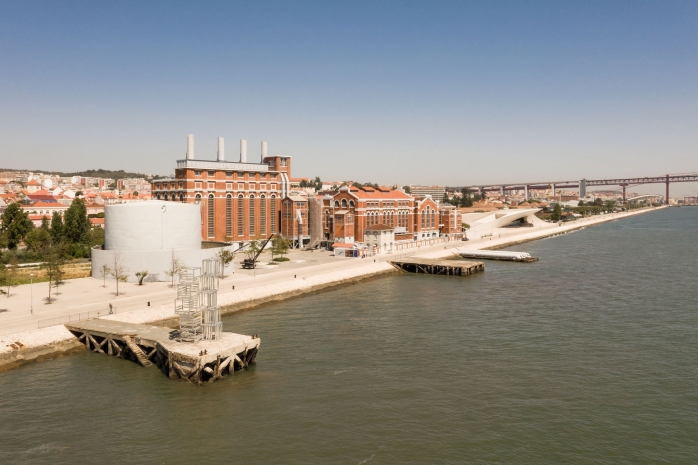Central

Built in 1908, Central Tejo was a thermal power station owned by Companhias Reunidas de Gás e Eletricidade (CRGE, United Gas and Electric Companies) which supplied the entire Lisbon region with electric power. It operated nonstop from 1909 to 1954 and remained in limited operation until the 1970s. At its peak, it had 15 boilers and 5 generators working.
Central Tejo’s architecture is typical of so-called “electricity factories” from the end of the 19th century, with monumental iron structures covered in brick and facades that display assorted influences, from art nouveau to classicism. The current building is the result of subsequent expansions to increase production capacity.
Classified as a Public Asset in 1986, it opened to the public for the first time in 1990 as the Electricity Museum. It later underwent restoration before reopening in 2006, and eventually become part of the EDP Foundation campus in 2016 with the launch of the adjacent maat building designed by the British architecture studio AL_A (Amanda Levete Architects).
The Power Station Tour offers to all audiences a journey through the history of the plant and the evolution of electricity and energy production up to the latest technological achievements of today’s renewables.
The programmes dedicated to showcasing the EDP Foundation Portuguese Art Collection and the EDP Foundation Energy Heritage Collection are presented within the spaces of Central Tejo.
maat
The building housing the Museum of Art, Architecture and Technology (maat) was designed by British architecture studio AL_A (Amanda Levete Architects) and opened to the public in 2016. It is the latest addition to the EDP Foundation campus, which also includes the repurposed Central Tejo power station built in 1908.
In the architects’ own words, “proposing a new relationship with the river and the wider world, the Museum is a powerful yet sensitive and low-slung building that explores the convergence of contemporary art, architecture and technology.”
The maat building was designed to blend structure and landscape and to allow people to walk over, under and through it, or along the riverside. Its roof, conceived as a public space, gives access to the city through a footbridge overpassing the railway, and offers unforgettable views of both Lisbon and the River Tagus.
Composed of almost 15,000 three-dimensional tiles, maat’s south façade captures the natural light, creating patterned reflections that change seasonally and according to the time of the day.
The interior was conceived as an extension of the public realm. With 3,000 square metres of exhibition area, the spaces are designed to articulate organically, allowing uninterrupted circulation through differently scaled volumes and reconfigurable functions. The waterfront is so essential to the project that the design found a way to reflect it inside: the overhanging roof that provides a welcome shade draws the sunlight bouncing off the water through skylights and into the building.
AL_A architecture studio was founded in 2009 by the RIBA Stirling Prize-winning architect Amanda Levete with Ho-Yin Ng, Alice Dietsch and Maximiliano Arrocet.
Gardens
The EDP Foundation campus and its buildings – maat and Central – are connected by a landscape project designed by Lebanese architect Vladimir Djurovic, offering an outstanding, free-access leisure space along Lisbon’s historic riverfront.
At a length of about 225 metres and an average width of 100 metres, the project makes reference to the riparian forests found in certain areas of the River Tagus and aims to highlight their inherent nature and characteristics through its contrast with the surrounding rich and varied vegetation. On the north side, the landscaping is reinforced by gentle mounds and dense tree vegetation to mute the noise of road and train traffic.
On the river side, a gravel beach punctuated by trees and benches made of tree trunks and placed in a seemingly random way favours permanence and relaxation, as does the open plaza with granite benches.
The core of the project consists of an area of mixed flowering meadow with scattered trees and a foot path paved in granite blocks that connects to the adjacent west parking. Located between the beach and the wooded spaces, this area accentuates the distinctive character of the two gardens, adds biodiversity to the space and simultaneously serves an educational purpose.
The gardens are home to two permanent installations: Placed on Either Side of the Light (1999) by Lawrence Weiner and Central Tejo (2018) by Pedro Cabrita Reis. In addition, the outdoor area hosts temporary art interventions and public programmes organised throughout the year.